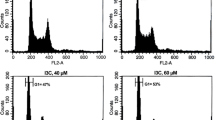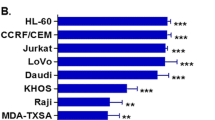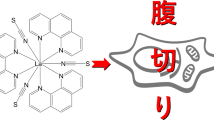Abstract
Alantolactone, an allergenic sesquiterpene lactone, has recently been found to have significant antitumor effects on malignant tumor cells. Here, we investigated the potential effect of alantolactone on Bcr/Abl+ imatinib-sensitive and -resistant cells. Alantolactone treatment resulted in obvious apoptosis in both imatinib-sensitive and -resistant K562 cells, as shown by the increase in Annexin V-positive cells, caspase-3 activation, poly(ADP-ribose) polymerase-1 (PARP-1) cleavage and mitochondrial membrane potential collapse. Alantolactone significantly inhibited NF-κB-dependent reporter gene activity, decreased the DNA-binding activity of NF-ОκB, and blocked TNF-α-induced IκBα phosphorylation. Of interest, the oncogenic Bcr/Abl fusion protein but not its mRNA levels were quickly reduced upon alantolactone exposure in imatinib-sensitive and -resistant K562 cells. Bcr/Abl knockdown enhanced the apoptosis driven by alantolactone. Bcr/Abl protein reduction could not be reversed by the addition of proteasome or caspase-3 inhibitors. The overexpression of p65 inhibited alantolactone-induced apoptosis, whereas p65 or Bcr/Abl silencing enhanced its apoptotic-inducing effect. Furthermore, Bcr/Abl-transfected 32D cells showed more sensitivity to alantolactone than vector-transfected control cells, and the Bcr/Abl protein was depleted, as observed in K562 cells. Finally, alantolactone-induced apoptosis was also observed in primary CD34+ CML leukemic cells. Collectively, these findings suggest that alantolactone is a promising potent agent to fight against CML cells via the inhibition of the NF-κB signaling pathway and depletion of the Bcr/Abl protein.






Similar content being viewed by others
References
Schiffer CA, Hehlmann R, Larson R (2003) Perspectives on the treatment of chronic phase and advanced phase CML and Philadelphia chromosome positive ALL(1). Leukemia 17:691–699
Melo JV, Barnes DJ (2007) Chronic myeloid leukaemia as a model of disease evolution in human cancer. Nat Rev Cancer 7:441–453
Voss J, Posern G, Hannemann JR et al (2000) The leukaemic oncoproteins Bcr–Abl and Tel–Abl (ETV6/Abl) have altered substrate preferences and activate similar intracellular signalling pathways. Oncogene 19:1684–1690
Danial NN, Rothman P (2000) JAK-STAT signaling activated by Abl oncogenes. Oncogene 19:2523–2531
Kirchner D, Duyster J, Ottmann O, Schmid RM, Bergmann L, Munzert G (2003) Mechanisms of Bcr–Abl-mediated NF-kappaB/Rel activation. Exp Hematol 31:504–511
Bedi A, Barber JP, Bedi GC et al (1995) BCR–ABL-mediated inhibition of apoptosis with delay of G2/M transition after DNA damage: a mechanism of resistance to multiple anticancer agents. Blood 86:1148–1158
Cortez D, Kadlec L, Pendergast AM (1995) Structural and signaling requirements for BCR–ABL-mediated transformation and inhibition of apoptosis. Mol Cell Biol 15:5531–5541
Dan S, Naito M, Tsuruo T (1998) Selective induction of apoptosis in Philadelphia chromosome-positive chronic myelogenous leukemia cells by an inhibitor of BCR–ABL tyrosine kinase, CGP 57148. Cell Death Differ 5:710–715
Druker BJ, Tamura S, Buchdunger E et al (1996) Effects of a selective inhibitor of the Abl tyrosine kinase on the growth of Bcr–Abl positive cells. Nat Med 2:561–566
Druker BJ, Talpaz M, Resta DJ et al (2001) Efficacy and safety of a specific inhibitor of the BCR–ABL tyrosine kinase in chronic myeloid leukemia. N Engl J Med 344:1031–1037
Weisberg E, Griffin JD (2000) Mechanism of resistance to the ABL tyrosine kinase inhibitor STI571 in BCR/ABL-transformed hematopoietic cell lines. Blood 95:3498–3505
le Coutre P, Tassi E, Varella-Garcia M et al (2000) Induction of resistance to the Abelson inhibitor STI571 in human leukemic cells through gene amplification. Blood 95:1758–1766
Krystal GW (2001) Mechanisms of resistance to imatinib (STI571) and prospects for combination with conventional chemotherapeutic agents. Drug Resist Updat 4:16–21
Gorre ME, Mohammed M, Ellwood K et al (2001) Clinical resistance to STI-571 cancer therapy caused by BCR–ABL gene mutation or amplification. Science 293:876–880
Shah NP, Tran C, Lee FY, Chen P, Norris D, Sawyers CL (2004) Overriding imatinib resistance with a novel ABL kinase inhibitor. Science 305:399–401
Weisberg E, Manley PW, Breitenstein W et al (2005) Characterization of AMN107, a selective inhibitor of native and mutant Bcr–Abl. Cancer Cell 7:129–141
Soverini S, Iacobucci I, Baccarani M, Martinelli G (2007) Targeted therapy and the T315I mutation in Philadelphia-positive leukemias. Haematologica 92:437–439
Quintas-Cardama A, Cortes J (2008) Therapeutic options against BCR–ABL1 T315I-positive chronic myelogenous leukemia. Clin Cancer Res 14:4392–4399
Saglio G, Kim DW, Issaragrisil S et al (2010) Nilotinib versus imatinib for newly diagnosed chronic myeloid leukemia. N Engl J Med 362:2251–2259
Cortes JE, Jones D, O’Brien S et al (2010) Results of dasatinib therapy in patients with early chronic-phase chronic myeloid leukemia. J Clin Oncol 28:398–404
Giles FJ, le Coutre PD, Pinilla-Ibarz J et al (2013) Nilotinib in imatinib-resistant or imatinib-intolerant patients with chronic myeloid leukemia in chronic phase: 48-month follow-up results of a phase II study. Leukemia 27:107–112
Stojakowska A, Michalska K, Malarz J (2006) Simultaneous quantification of eudesmanolides and thymol derivatives from tissues of Inula helenium and I. royleana by reversed-phase high-performance liquid chromatography. Phytochem Anal PCA 17:157–161
Dirsch VM, Stuppner H, Vollmar AM (2001) Cytotoxic sesquiterpene lactones mediate their death-inducing effect in leukemia T cells by triggering apoptosis. Planta Med 67:557–559
Konishi T, Shimada Y, Nagao T, Okabe H, Konoshima T (2002) Antiproliferative sesquiterpene lactones from the roots of Inula helenium. Biol Pharm Bull 25:1370–1372
Lawrence NJ, McGown AT, Nduka J, Hadfield JA, Pritchard RG (2001) Cytotoxic Michael-type amine adducts of alpha-methylene lactones alantolactone and isoalantolactone. Bioorg Med Chem Lett 11:429–431
Pal HC, Sehar I, Bhushan S, Gupta BD, Saxena AK (2010) Activation of caspases and poly (ADP-ribose) polymerase cleavage to induce apoptosis in leukemia HL-60 cells by Inula racemosa. Toxicol In Vitro 24:1599–1609
Shi Y, Bao YL, Wu Y et al (2011) Alantolactone inhibits cell proliferation by interrupting the interaction between Cripto-1 and activin receptor type II A in activin signaling pathway. J Biomol Screen 16:525–535
Wang YY, Zhao LJ, Wu CF et al (2011) C-KIT mutation cooperates with full-length AML1-ETO to induce acute myeloid leukemia in mice. Proc Natl Acad Sci USA 108:2450–2455
Funakoshi-Tago M, Nakamura K, Tsuruya R et al (2010) The fixed structure of Licochalcone A by alpha, beta-unsaturated ketone is necessary for anti-inflammatory activity through the inhibition of NF-kappaB activation. Int Immunopharmacol 10:562–571
Reuther JY, Reuther GW, Cortez D, Pendergast AM, Baldwin AS Jr (1998) A requirement for NF-kappaB activation in Bcr–Abl-mediated transformation. Genes Dev 12:968–981
Hanson JL, Anest V, Reuther-Madrid J, Baldwin AS (2003) Oncoprotein suppression of tumor necrosis factor-induced NF kappa B activation is independent of Raf-controlled pathways. J Biol Chem 278:34910–34917
Rocha S, Campbell KJ, Perkins ND (2003) p53- and Mdm2-independent repression of NF-kappa B transactivation by the ARF tumor suppressor. Mol Cell 12:15–25
Lu Z, Jin Y, Chen C, Li J, Cao Q, Pan J (2010) Pristimerin induces apoptosis in imatinib-resistant chronic myelogenous leukemia cells harboring T315I mutation by blocking NF-kappaB signaling and depleting Bcr–Abl. Mol Cancer 9:112
Guzman ML, Rossi RM, Karnischky L et al (2005) The sesquiterpene lactone parthenolide induces apoptosis of human acute myelogenous leukemia stem and progenitor cells. Blood 105:4163–4169
Xu B, Guo X, Mathew S et al (2010) Triptolide simultaneously induces reactive oxygen species, inhibits NF-kappaB activity and sensitizes 5-fluorouracil in colorectal cancer cell lines. Cancer Lett 291:200–208
Mao JH, Sun XY, Liu JX et al (2010) As4S4 targets RING-type E3 ligase c-CBL to induce degradation of BCR–ABL in chronic myelogenous leukemia. Proc Natl Acad Sci USA 107:21683–21688
Demidenko ZN, An WG, Lee JT, Romanova LY, McCubrey JA, Blagosklonny MV (2005) Kinase-addiction and bi-phasic sensitivity-resistance of Bcr–Abl- and Raf-1-expressing cells to imatinib and geldanamycin. Cancer Biol Ther 4:484–490
Bartholomeusz GA, Talpaz M, Kapuria V et al (2007) Activation of a novel Bcr/Abl destruction pathway by WP1130 induces apoptosis of chronic myelogenous leukemia cells. Blood 109:3470–3478
Orsolic N, Golemovic M, Quintas-Cardama A et al (2006) Adaphostin has significant and selective activity against chronic and acute myeloid leukemia cells. Cancer Sci 97:952–960
Decker RH, Dai Y, Grant S (2001) The cyclin-dependent kinase inhibitor flavopiridol induces apoptosis in human leukemia cells (U937) through the mitochondrial rather than the receptor-mediated pathway. Cell Death Differ 8:715–724
Nelson EA, Walker SR, Weisberg E et al (2011) The STAT5 inhibitor pimozide decreases survival of chronic myelogenous leukemia cells resistant to kinase inhibitors. Blood 117:3421–3429
Tanaka R, Squires MS, Kimura S et al (2010) Activity of the multitargeted kinase inhibitor, AT9283, in imatinib-resistant BCR–ABL-positive leukemic cells. Blood 116:2089–2095
Puttini M, Coluccia AM, Boschelli F et al (2006) In vitro and in vivo activity of SKI-606, a novel Src-Abl inhibitor, against imatinib-resistant Bcr–Abl+ neoplastic cells. Cancer Res 66:11314–11322
Yan H, Wang YC, Li D et al (2007) Arsenic trioxide and proteasome inhibitor bortezomib synergistically induce apoptosis in leukemic cells: the role of protein kinase Cdelta. Leukemia 21:1488–1495
Carter BZ, Mak DH, Cortes J, Andreeff M (2010) The elusive chronic myeloid leukemia stem cell: does it matter and how do we eliminate it? Semin Hematol 47:362–370
Acknowledgments
This work was supported in part by the National Basic Research Program of China (973 Program) (NO. 2010CB912104); National Natural Science Foundation (81170509, 81070433, 91013008, 81272886, 30570777); Science and Technology Committee of Shanghai (11JC1406500); SMC Program of Shanghai Jiao Tong University. We thank Dr Melo JV for her kindly provided the K562 and K562r cells.
Conflict of interest
The authors declare no conflict of interest.
Author information
Authors and Affiliations
Corresponding authors
Additional information
Wei Wei and He Huang contributed equally to this study.
Rights and permissions
About this article
Cite this article
Wei, W., Huang, H., Zhao, S. et al. Alantolactone induces apoptosis in chronic myelogenous leukemia sensitive or resistant to imatinib through NF-κB inhibition and Bcr/Abl protein deletion. Apoptosis 18, 1060–1070 (2013). https://doi.org/10.1007/s10495-013-0854-2
Published:
Issue Date:
DOI: https://doi.org/10.1007/s10495-013-0854-2




